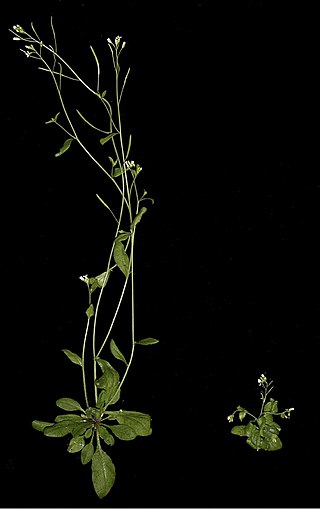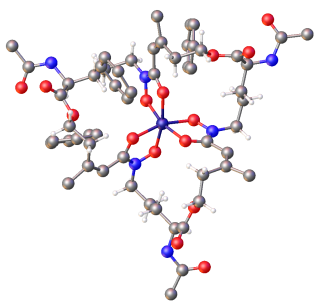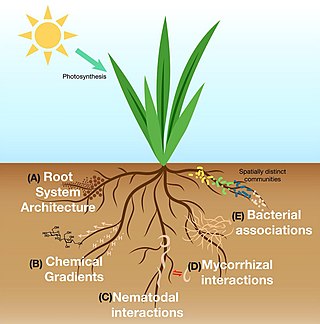Signaling

A phytobiome consists of a plant (phyto) situated in its specific ecological area (biome), including its environment and the associated communities of organisms which inhabit it. These organisms include all macro- and micro-organisms living in, on, or around the plant including bacteria, archaea, fungi, protists, insects, animals, and other plants. The environment includes the soil, air, and climate. Examples of ecological areas are fields, rangelands, forests. [1] Knowledge of the interactions within a phytobiome can be used to create tools for agriculture, crop management, [2] increased health, preservation, productivity, and sustainability of cropping and forest systems. [3] [4]

The microbial community within the phytobiome is perhaps one of the most rich and diverse microbiomes on Earth. Plants form associations with billions of organisms across every kingdom of life. Recent metagenomic and metatranscriptomic approaches have allowed scientists to discover novel taxonomic species that are not easily cultured in a laboratory.
Recent research has shown that inter-kingdom communication between organisms is essential for proper phytobiome function. [5] There are numerous physical and chemical signals such as secreted lipids, peptides and polysaccharides that allow organisms to recognize and interact within the phytobiome. Bacteria are known to produce quorum sensing molecules such as homoserine lactones, lipid-like diffusable factors and signaling peptides that mediate plant-bacteria interactions such as colonization. [5] Homoserine lactones have been are reportedly produced by a large number of bacteria found in the rhizosphere. [6] Plant growth promoting bacteria (PGPBs) often produce Nod factors (nodulation factors) that initiate nodule formation in plants. [5] In addition to plant-bacterial interactions, bacteria often secrete bactericidal or fungicidal compounds into the phytobiome to reduce local competition for niches and resources. [5] Additionally, organisms that feed on bacteria such as some species of algae and protists are attracted to these small signaling molecules. [5]
Bacteriophages also play a critical role in the phytobiome through predator-prey interactions. Bacteriophages use a signaling peptides such as arbitrium to mediate the initiation of cell lysis and lysogeny in the host cell. [7]
Fungi communicate in the phytobiome through chemical signaling to aid in sexual reproduction, sporulation, cell-to-cell recognition and antibiosis; however, only a fraction of these chemicals have been studied for their function. [5] Mycorrhizal fungi establish symbiotic relationships with plants through the production of Myc factors, or chitooligosaccharides that are recognized by receptors in the plant. [8] Nematode-trapping fungi often utilize fungal signaling molecules to initiate morphogenesis towards prey. [5] Other organisms can interfere with fungal signaling, such as plant-produced oxylipins that mimic fungal signaling molecules and can regulate fungal development or reduce virulence. [5] Multiple species of bacteria, insects and nematodes have all been reported to respond to fungal signaling compounds. [8]
Very little is known about nematode communication within the phytobiome. Plant-pathogenic nematodes often communicate through production of pheromones. [5] Plants can detect these compounds and induce defense pathways. [5] Nematodes also produce plant hormones such as cytokinins that aid in the establishment of association with plants. [5]
Perhaps even less is known about the ecological role of protists and viruses within the phytobiome. Some amoebae species use cyclic nucleotides or peptide signals to adapt social behavior. [5] Phytohormones produced by algae-associated bacteria can greatly impact microalgae populations in the soil. [5] The presence of amoeba can also trigger the bacterium P. fluorescens to produce anti-amoebal toxins. [9]
Insects communicate to transfer information regarding external threats, social status, food availability and mating through the production of volatile pheromones, also known as semiochemicals. [5] This has made pheromones a subject of research since the 1950s for various applications in agriculture and insect-vectored diseases such as malaria. [5] Plants can have profound impacts on insect pheromone production. Rattlebox plants produce various alkaloid compounds that insects use as a precursor for sex pheromone synthesis. [5] Many plant species have evolved production of volatile chemicals that interfere with pheromone signaling, often through inhibition of proper olfactory neuron function. [5] Bacteria and fungi can also produce volatile chemicals that affect insect behavior. [10]
The presence of plants and their communication with other community members fundamentally shapes the phytobiome. Root exudates contain numerous sugars, amino acids, polysaccharides and secondary metabolites. [5] The production of these exudates is heavily influenced by environmental factors and plant physiology and can alter the community composition of the rhizosphere and rhizoplane. [5] The secretion of flavonoids helps to recruit Rhizobia bacteria that form a mutualistic symbiosis with numerous plant species. [5] Rhizobia can also recognize other plant compounds such as betaines, aldonic acids and jasmonic acid. [8] These signal molecules can have multiple or even counteracting effects. For example, plant cutins trigger arbuscular mycorrhizal colonization and symbiosis but can also be recognized by plant-pathogenic oomycetes and trigger pathogenesis. [11] Plant volatile chemicals also attract herbivores, pollinators and seed carriers.
When plants recognize the presence of microbes, they often activate the production of phytohormone signals that are transported throughout the plant. Plants respond to pathogens and herbivores through production of hormones including salicylic acid, jasmonic acid and ethylene. [12] In addition, many phytohormones that function in abiotic stress tolerance or plant growth also trigger responses with the microbial community. The production of salicylic acid in Arabidopsis was shown to influence the root microbiome composition by acting as a signal or carbon source. [13] Secretion of strigolactone is known to stimulate spore germination and Myc factor production in arbuscular mycorrhizal fungi. [5]
The microbial community can also manipulate phytohormone function or the production of specific phytohormones in plants.
In 2015 the American Phytopathological Society (APS) launched a research framework, the Phytobiomes Initiative, to facilitate the organization of research into phytobiome. [14] As part of this effort, in 2016 it launched Phytobiomes Journal , an open-access journal. The journal focuses on transdisciplinary research that impacts the entire plant ecosystem. [15] An overall research strategy has been published in the Phytobiomes Roadmap, a document developed by a group of scientific societies, companies, research institutes, and governmental agencies. It is intended to present a strategic plan to study phytobiomes and propose an action plan to apply phytobiome studies. [16] [17] The connected Phytobiomes Alliance is an international, nonprofit consortium of academic institutions, large and small companies, and governmental agencies coordinating public-private research projects on various aspects of agriculturally relevant phytobiomes. [18]

An endosymbiont or endobiont is any organism that lives within the body or cells of another organism most often, though not always, in a mutualistic relationship. This phenomenon is known as endosymbiosis. Examples are nitrogen-fixing bacteria, which live in the root nodules of legumes, single-cell algae inside reef-building corals and bacterial endosymbionts that provide essential nutrients to insects.

A mycorrhiza is a symbiotic association between a fungus and a plant. The term mycorrhiza refers to the role of the fungus in the plant's rhizosphere, its root system. Mycorrhizae play important roles in plant nutrition, soil biology, and soil chemistry.

Plant pathology or phytopathology is the scientific study of plant diseases caused by pathogens and environmental conditions. Plant pathology involves the study of pathogen identification, disease etiology, disease cycles, economic impact, plant disease epidemiology, plant disease resistance, how plant diseases affect humans and animals, pathosystem genetics, and management of plant diseases.

Plant hormones are signal molecules, produced within plants, that occur in extremely low concentrations. Plant hormones control all aspects of plant growth and development, including embryogenesis, the regulation of organ size, pathogen defense, stress tolerance and reproductive development. Unlike in animals each plant cell is capable of producing hormones. Went and Thimann coined the term "phytohormone" and used it in the title of their 1937 book.

An endophyte is an endosymbiont, often a bacterium or fungus, that lives within a plant for at least part of its life cycle without causing apparent disease. Endophytes are ubiquitous and have been found in all species of plants studied to date; however, most of the endophyte/plant relationships are not well understood. Some endophytes may enhance host growth, nutrient acquisition and improve the plant's ability to tolerate abiotic stresses, such as drought and decrease biotic stresses by enhancing plant resistance to insects, pathogens and herbivores. Although endophytic bacteria and fungi are frequently studied, endophytic archaea are increasingly being considered for their role in plant growth promotion as part of the core microbiome of a plant.

Siderophores (Greek: "iron carrier") are small, high-affinity iron-chelating compounds that are secreted by microorganisms such as bacteria and fungi. They help the organism accumulate iron. Although a widening range of siderophore functions is now being appreciated, siderophores are among the strongest (highest affinity) Fe3+ binding agents known. Phytosiderophores are siderophores produced by plants.

An arbuscular mycorrhiza (AM) is a type of mycorrhiza in which the symbiont fungus penetrates the cortical cells of the roots of a vascular plant forming arbuscules. Arbuscular mycorrhiza is a type of endomycorrhiza along with ericoid mycorrhiza and orchid mycorrhiza .They are characterized by the formation of unique tree-like structures, the arbuscules. In addition, globular storage structures called vesicles are often encountered.
A biopesticide is a biological substance or organism that damages, kills, or repels organisms seen as pests. Biological pest management intervention involves predatory, parasitic, or chemical relationships.

The rhizosphere is the narrow region of soil or substrate that is directly influenced by root secretions and associated soil microorganisms known as the root microbiome. Soil pores in the rhizosphere can contain many bacteria and other microorganisms that feed on sloughed-off plant cells, termed rhizodeposition, and the proteins and sugars released by roots, termed root exudates. This symbiosis leads to more complex interactions, influencing plant growth and competition for resources. Much of the nutrient cycling and disease suppression by antibiotics required by plants occurs immediately adjacent to roots due to root exudates and metabolic products of symbiotic and pathogenic communities of microorganisms. The rhizosphere also provides space to produce allelochemicals to control neighbours and relatives.

The innate, or nonspecific, immune system is one of the two main immunity strategies in vertebrates. The innate immune system is an alternate defense strategy and is the dominant immune system response found in plants, fungi, prokaryotes, and invertebrates.

Phospholipid-derived fatty acids (PLFAs) are widely used in microbial ecology as chemotaxonomic markers of bacteria and other organisms. Phospholipids are the primary lipids composing cellular membranes. Phospholipids can be saponified, which releases the fatty acids contained in their diglyceride tail. Once the phospholipids of an unknown sample are saponified, the composition of the resulting PLFA can be compared to the PLFA of known organisms to determine the identity of the sample organism. PLFA analysis may be combined with other techniques, such as stable isotope probing to determine which microbes are metabolically active in a sample. PLFA analysis was pioneered by D.C. White at the University of Tennessee, in the early to mid 1980s.

Microbiota are the range of microorganisms that may be commensal, mutualistic, or pathogenic found in and on all multicellular organisms, including plants. Microbiota include bacteria, archaea, protists, fungi, and viruses, and have been found to be crucial for immunologic, hormonal, and metabolic homeostasis of their host.
Biotic stress is stress that occurs as a result of damage done to an organism by other living organisms, such as bacteria, viruses, fungi, parasites, beneficial and harmful insects, weeds, and cultivated or native plants. It is different from abiotic stress, which is the negative impact of non-living factors on the organisms such as temperature, sunlight, wind, salinity, flooding and drought. The types of biotic stresses imposed on an organism depend the climate where it lives as well as the species' ability to resist particular stresses. Biotic stress remains a broadly defined term and those who study it face many challenges, such as the greater difficulty in controlling biotic stresses in an experimental context compared to abiotic stress.
Soil microbiology is the study of microorganisms in soil, their functions, and how they affect soil properties. It is believed that between two and four billion years ago, the first ancient bacteria and microorganisms came about on Earth's oceans. These bacteria could fix nitrogen, in time multiplied, and as a result released oxygen into the atmosphere. This led to more advanced microorganisms, which are important because they affect soil structure and fertility. Soil microorganisms can be classified as bacteria, actinomycetes, fungi, algae and protozoa. Each of these groups has characteristics that define them and their functions in soil.

A mycorrhizal network is an underground network found in forests and other plant communities, created by the hyphae of mycorrhizal fungi joining with plant roots. This network connects individual plants together. Mycorrhizal relationships are most commonly mutualistic, with both partners benefiting, but can be commensal or parasitic, and a single partnership may change between any of the three types of symbiosis at different times.

The root microbiome is the dynamic community of microorganisms associated with plant roots. Because they are rich in a variety of carbon compounds, plant roots provide unique environments for a diverse assemblage of soil microorganisms, including bacteria, fungi, and archaea. The microbial communities inside the root and in the rhizosphere are distinct from each other, and from the microbial communities of bulk soil, although there is some overlap in species composition.

The mycobiome, mycobiota, or fungal microbiome, is the fungal community in and on an organism.

Strigolactones are a group of chemical compounds produced by roots of plants. Due to their mechanism of action, these molecules have been classified as plant hormones or phytohormones. So far, strigolactones have been identified to be responsible for three different physiological processes: First, they promote the germination of parasitic organisms that grow in the host plant's roots, such as Strigalutea and other plants of the genus Striga. Second, strigolactones are fundamental for the recognition of the plant by symbiotic fungi, especially arbuscular mycorrhizal fungi, because they establish a mutualistic association with these plants, and provide phosphate and other soil nutrients. Third, strigolactones have been identified as branching inhibition hormones in plants; when present, these compounds prevent excess bud growing in stem terminals, stopping the branching mechanism in plants.
Plant root exudates are fluids emitted through the roots of plants. These secretions influence the rhizosphere around the roots to inhibit harmful microbes and promote the growth of self and kin plants.

Since the colonization of land by ancestral plant lineages 450 million years ago, plants and their associated microbes have been interacting with each other, forming an assemblage of species that is often referred to as a holobiont. Selective pressure acting on holobiont components has likely shaped plant-associated microbial communities and selected for host-adapted microorganisms that impact plant fitness. However, the high microbial densities detected on plant tissues, together with the fast generation time of microbes and their more ancient origin compared to their host, suggest that microbe-microbe interactions are also important selective forces sculpting complex microbial assemblages in the phyllosphere, rhizosphere, and plant endosphere compartments.